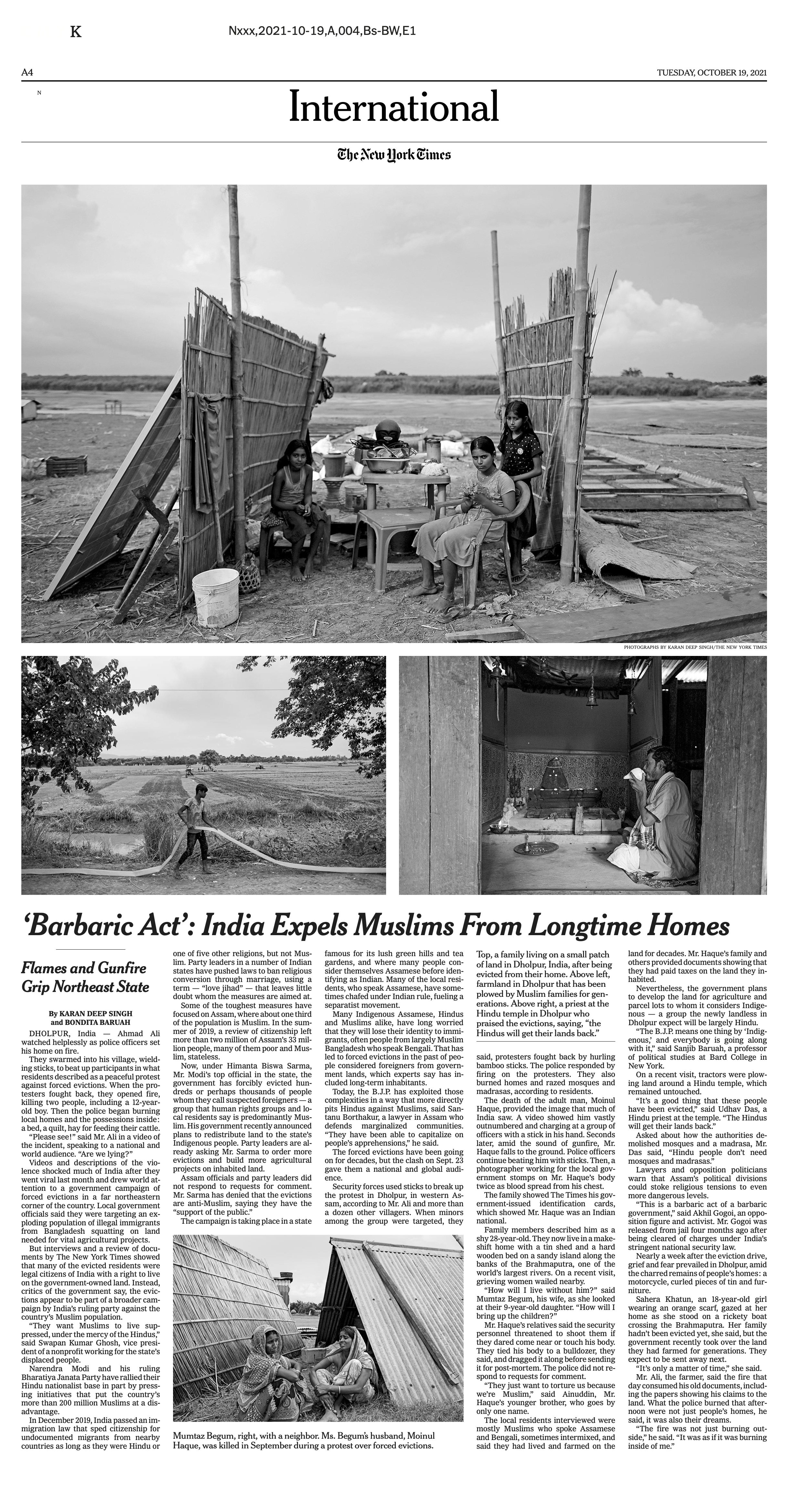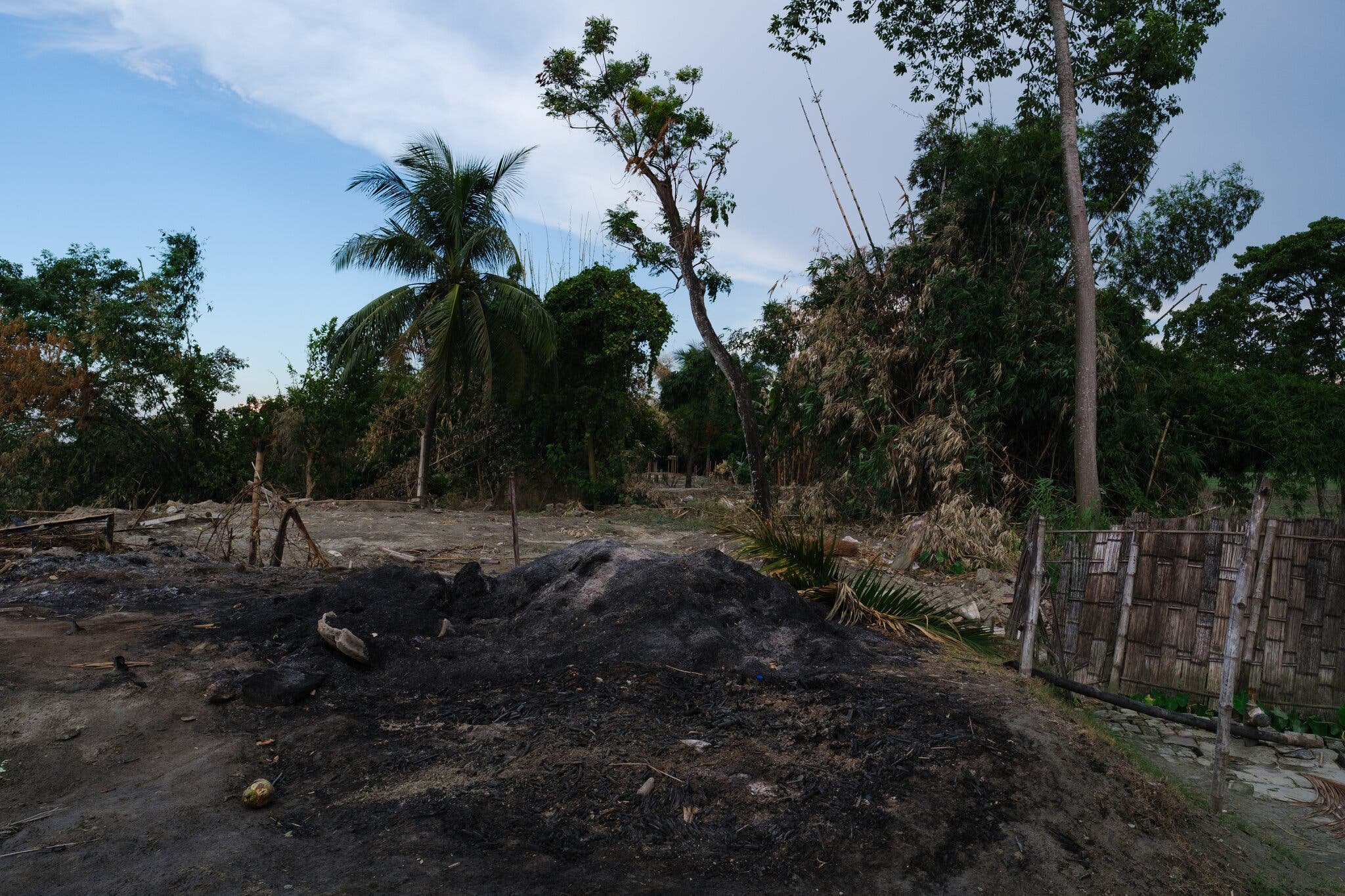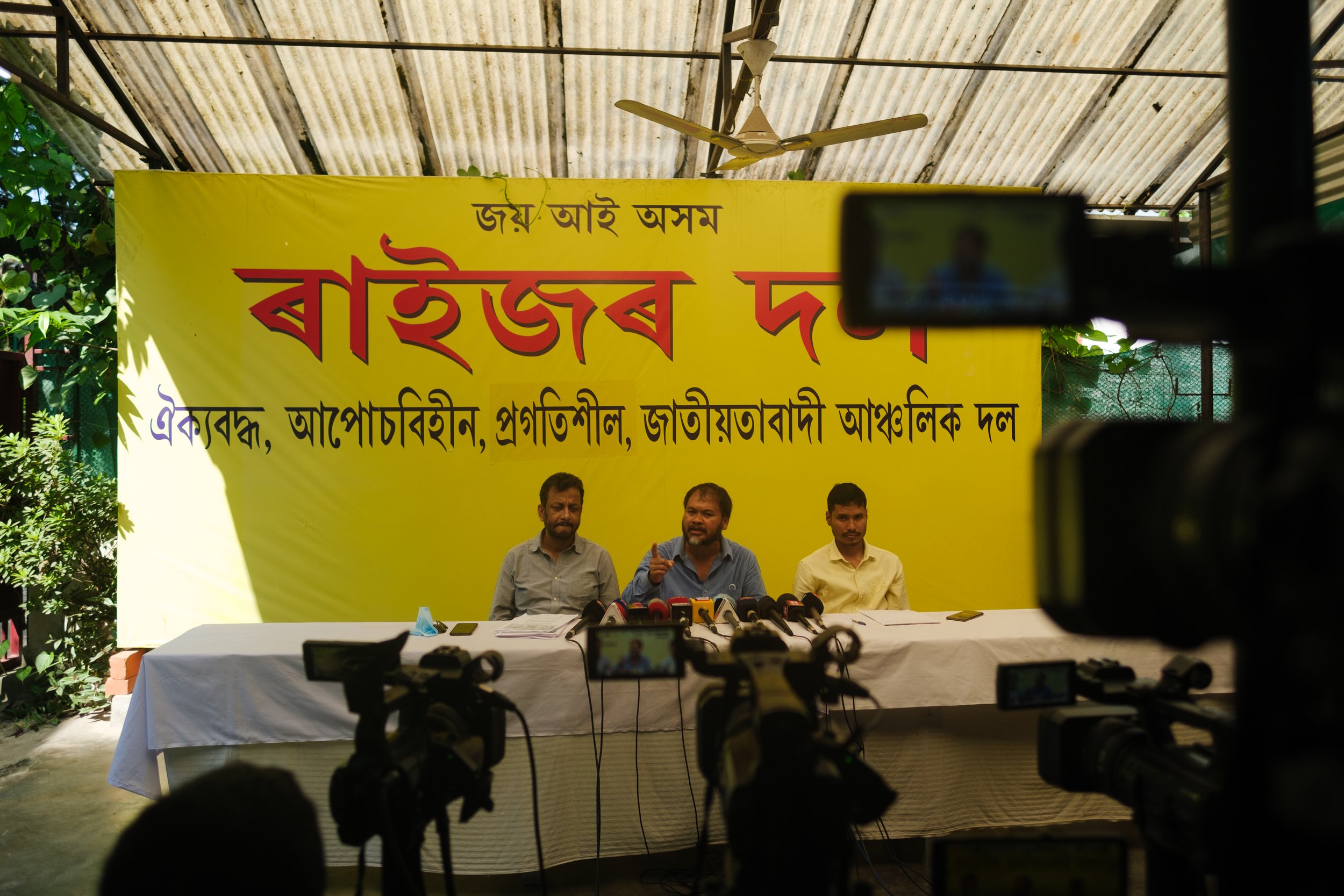Amid Flames and Gunfire, They Were Evicted From Where They Called HomE
THE NEW YORK TIMES, OCT 17, 2021
A family arriving at a small patch of land after being evicted from their home. Photo: Karan Deep Singh/The New York Times
Critics say an Indian state’s campaign to expel longtime residents on government land marks the ruling party’s latest campaign against Muslims
BY KARAN DEEP SINGH AND BONDITA BARUAH
DHOLPUR, India — Ahmad Ali watched helplessly as the police set his home on fire.
They swarmed into his village, wielding sticks, to beat up participants in what local residents described as a peaceful protest against forced evictions. When the protesters fought back, they opened fire, killing two people, including a 12-year-old boy. Then the police began burning local homes and the possessions inside: a bed, a quilt, hay for feeding their cattle.
“Please see!” said Mr. Ali in a video of the incident, speaking to a national and world audience. “Are we lying?”
Videos and descriptions of the violence shocked much of India after they went viral last month and drew world attention to a government campaign of forced evictions in a far northeastern corner of the country. Local government officials said they were targeting an exploding population of illegal immigrants from Bangladesh squatting on land needed for vital agricultural projects.
Ahmad Ali said he watched the police burn down his home last month. Photo: Karan Deep Singh/The New York Times
But interviews and a review of documents by The New York Times showed that many of the evicted residents were legal citizens of India with a right to live on the government-owned land. Instead, critics of the government say, the evictions appear to be part of a broader campaign by India’s ruling party against the country’s Muslim population.
“They want Muslims to live suppressed, under the mercy of the Hindus,” said Swapan Kumar Ghosh, vice president of a nonprofit working for the state’s displaced people.
Narendra Modi and his ruling Bharatiya Janata Party have rallied their Hindu nationalist base in part by pressing initiatives that put the country’s more than 200 million Muslims at a disadvantage.
In December 2019, India passed an immigration law that fast tracked citizenship for undocumented migrants from nearby countries as long as they were Hindu or one of five other religions, but not Muslim. Party leaders in a number of Indian states have pushed laws to ban religious conversion through marriage, using a term — “love jihad” — that leaves little doubt whom the measures are aimed at.
The burnt remains of a home that had been torched in Dholpur, India. Photo: Karan Deep Singh/The New York Times
Some of the toughest measures have focused on Assam, where about one-third of the population is Muslim. In the summer of 2019, a review of citizenship left more than two million of Assam’s 33 million people, many of them poor and Muslim, stateless.
Now, under Himanta Biswa Sarma, Mr. Modi’s top official in the state, the government has forcibly evicted hundreds or perhaps thousands of people whom they call suspected foreigners — a group that human rights groups and local residents say is predominantly Muslim. His government recently announced plans to redistribute land to the state’s Indigenous people. Party leaders are already asking Mr. Sarma to order more evictions and build more agricultural projects on inhabited land.
Assam officials and party leaders did not respond to requests for comment. Mr. Sarma has denied that the evictions are anti-Muslim, saying they have the “support of the public.”
The campaign is taking place in a state famous for its lush green hills and tea gardens, and where many people consider themselves Assamese before identifying as Indian. Many of the local residents, who speak Assamese, have sometimes chafed under Indian rule, fueling a separatist movement.
Santanu Borthakur, a lawyer in Guwahati, the capital of Assam state, accused the government of exploiting the demographic complexity of Assam to pit Hindus against Muslims. Photo: Karan Deep Singh/The New York Times
Many Indigenous Assamese, Hindus and Muslims alike, have long worried that they will lose their identity to immigrants, often people from largely Muslim Bangladesh who speak Bengali. That has led to forced evictions in the past of people considered foreigners from government lands, which experts say has included long-term inhabitants.
Today, the B.J.P. has exploited those complexities in a way that more directly pits Hindus against Muslims, said Santanu Borthakur, a lawyer in Assam who defends marginalized communities. “They have been able to capitalize on people’s apprehensions,” he said.
The forced evictions have been going on for decades, but the clash on Sept. 23 gave them a national and global audience.
Security forces used sticks to break up the protest in Dholpur, in western Assam, according to Mr. Ali and more than a dozen other villagers. When minors among the group were targeted, they said, protesters fought back by hurling bamboo sticks. The police responded by firing on the protesters. They also burned homes and razed mosques and madrasas, according to residents.
Moinul Haque’s wife, Mumtaz Begum, right, with a neighbor. Mr. Haque was shot by the police and the woman’s son was injured by a gunfire during an eviction drive that turned violent in the Dholpur area. Photo: Karan Deep Singh/The New York Times
The death of the adult man, Moinul Haque, provided the image that much of India saw. A video showed him vastly outnumbered and charging at a group of officers with a stick in his hand. Seconds later, amid the sound of gunfire, Mr. Haque falls to the ground. Police officers continue beating him with sticks. Then, a photographer working for the local government stomps on Mr. Haque’s body twice as blood spread from his chest.
The family showed The Times his government-issued identification cards, which showed Mr. Haque was an Indian national.
Family members described him as a shy 28-year-old. They now live in a makeshift home with a tin shed and a hard wooden bed on a sandy island along the banks of the Brahmaputra, one of the world’s largest rivers. On a recent visit, grieving women wailed nearby.
“How will I live without him?” said Mumtaz Begum, his wife, as she looked at their 9-year-old daughter. “How will I bring up the children?”
Government-run tractors in the background plowing land that the people of Dholpur have farmed for generations. Photo: Karan Deep Singh/The New York Times
Mr. Haque’s relatives said the security personnel threatened to shoot them if they dared come near or touch his body. They tied his body to a bulldozer, they said, and dragged it along before sending it for post-mortem. The police did not respond to requests for comment.
“They just want to torture us because we’re Muslim,” said Ainuddin, Mr. Haque’s younger brother, who goes by only one name.
The local residents interviewed were mostly Muslims who spoke Assamese and Bengali, sometimes intermixed, and said they had lived and farmed on the land for decades. Mr. Haque’s family and others provided documents showing that they had paid taxes on the land they inhabited.
Nevertheless, the government plans to develop the land for agriculture and parcel lots to whom it considers Indigenous — a group of people the newly landless in Dholpur expect will be largely Hindu.
Udhav Das, 30, a priest at the Hindu temple in Dholpur, praised the evictions, saying Hindus would benefit by getting “their lands back.” Photo: Karan Deep Singh/The New York Times
“The B.J.P. means one thing by ‘Indigenous,’ and everybody is going along with it,” said Sanjib Baruah, a professor of political studies at Bard College in New York.
On a recent visit, tractors were plowing land around a Hindu temple, which remained untouched.
“It’s a good thing that these people have been evicted,” said Udhav Das, a Hindu priest at the temple. “The Hindus will get their lands back.”
Asked about how the authorities demolished mosques and a madrasa, Mr. Das said, “Hindu people don’t need mosques and madrasas.”
Lawyers and opposition politicians warn that Assam’s political divisions could stoke religious tensions to even more dangerous levels.
“This is a barbaric act of a barbaric government,” said Akhil Gogoi, an opposition figure and activist. Mr. Gogoi was released from jail four months ago after being cleared of charges under India’s stringent national security law.
Akhil Gogoi, center, is an opposition figure and advocate for peasants’ rights. Mr. Gogoi was released from jail four months ago after being cleared of charges under a stringent national security law for his role in protests in December 2019. Photo: Karan Deep Singh/The New York Times
Nearly a week after the eviction drive, grief and fear prevailed in Dholpur, amid the charred remains of people’s homes: a motorcycle, curled pieces of tin and furniture.
Sahera Khatun, an 18-year-old girl wearing an orange scarf, gazed at her home as she stood on a rickety boat crossing the Brahmaputra. Her family hadn’t been evicted yet, she said, but the government recently took over the land they had farmed for generations. They expect to be sent away next.
“It’s only a matter of time,” she said.
Mr. Ali, the farmer, said the fire that day consumed his old documents, including the papers showing his claims to the land. What the police burned that afternoon were not just people’s homes, he said, it was also their dreams.
“The fire was not just burning outside,” he said. “It was as if it was burning inside of me.”
An elderly man carrying a bamboo pole and a baby across a stream of the Brahmaputra river after being evicted. Photo: Karan Deep Singh/The New York Times
READ THE STORY ON THE NEW YOKR TIMES WEBSITE.
Published on Page 4, Oct. 19, 2021, New York edition of The New York Times









